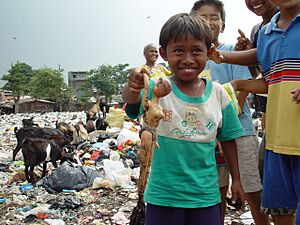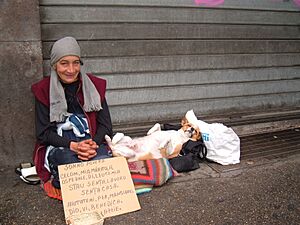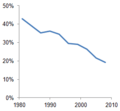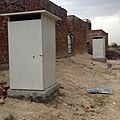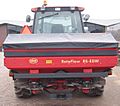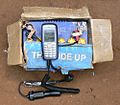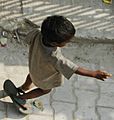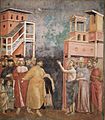Poverty facts for kids
Poverty means not having enough money for basic needs. This includes things like food, clean drinking water, a safe shelter, or even toiletries. Many people around the world live in poverty. This is especially true in developing areas like parts of West Africa, Sub-Saharan Africa, Latin America, the Caribbean, and some parts of Asia.
There are different ways to measure how many people live in poverty. The World Bank says that extreme poverty means someone lives on less than US$1.90 a day. This amount is adjusted for things like inflation. Inflation means that prices for goods and services go up over time. Moderate poverty means people live on less than $2 or $5 a day. In 2001, about 1.1 billion people were considered extremely poor. Around 2.7 billion people were seen as moderately poor.
In richer countries, poverty can look different. Many people are called the working poor. They have a job, but they don't earn enough money for basic things like food and a home. In most developed countries, people without jobs might get money from the government. But this money is often not enough for a comfortable life.
Contents
How Do We Measure Poverty?
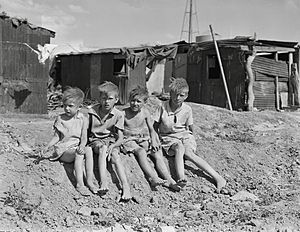
What Is Absolute Poverty?
Absolute poverty is a fixed standard of not having basic human needs. This includes food, safe drinking water, sanitation, health care, shelter, education, and information. It's not just about how much money you earn. It's also about whether you can get these important services. If your income is below the poverty line, which is the money needed for basic things, it's called primary poverty.
The "dollar a day" idea started in 1990 to measure this. For countries that don't use US dollars, it's not just about the exchange rate. Instead, they use something called purchasing power parity. This looks at how much local money is needed to buy the same things a dollar would buy in the United States. Usually, this means you need less local money than if you just used the exchange rate. This is because the United States is a more expensive country.
The World Bank has updated its definition of absolute poverty over time. In 2015, it was set at living on less than US$1.90 per day. Moderate poverty was less than $2 or $5 a day. Some experts disagree on this $1.90 per day line. Some think it's too high, while others think it's too low. They argue that a higher line, like $7.40 or even $10 to $15 a day, would better show the real cost of basic needs.
Some experts believe that the true number of people in poverty is much higher. One estimate suggests that 4.3 billion people (59% of the world's population) live on less than $5 a day. They struggle to meet their basic needs. A UN expert, Philip Alston, said the World Bank's $1.90 line is flawed. He believes it makes it seem like we're doing better against global poverty than we really are. He states that almost half the world, about 3.4 billion people, live on less than $5.50 a day. This number has barely changed since 1990.
Other ways to measure absolute poverty don't use a dollar amount. One way is when people get less than 80% of the minimum calories they need. Also, they might spend more than 80% of their income on food. This is sometimes called ultra-poverty.
What Is Relative Poverty?
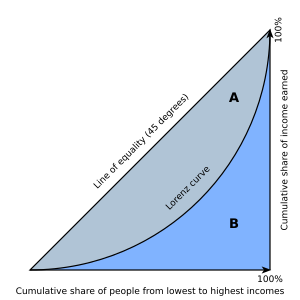
Relative poverty looks at poverty based on the society someone lives in. It means that what is considered "basic needs" can change depending on the customs of a society. For example, if almost everyone in an area lives in modern homes, a person living in a small tent would be in relative poverty. But if everyone else also lived in tents, they might not be.
Relative poverty is often measured as the percentage of people whose income is less than a certain part of the average income. In many rich countries, like those in the OECD and European Union, the poverty line is set at 60% of the average household income. This measure is very useful for understanding poverty in wealthy nations.
How Can We Help Reduce Poverty?
Poverty makes it harder for a country to grow and improve. One way to help reduce poverty is by educating poor people. When people are educated, they can get better jobs. This helps them earn more money and contribute to their nation's economic development. Education also teaches people about their rights. It can show them how to become an important part of their country's growth. The Vienna Declaration also highlights this fact.
A very important step to make a country richer is for the government to truly want to help poor people. Without this strong desire from leaders, it is very difficult for people to improve their lives.
Related Pages
- Corruption
- Constitution
- Constitutional economics
- Feminization of poverty
- Poverty line
- Make Poverty History
- Right to an adequate standard of living
- World Poverty and Human Rights
Images for kids
-
Percentage of population suffering from hunger, World Food Programme, 2008
-
This graph shows the proportion of world population in extreme poverty 1981–2008 according to the World Bank.
-
Street child in Bangladesh. Aiding relatives financially unable to but willing to take in orphans is found to be more effective by cost and welfare than orphanages.
-
Affordable household toilets near Jaipur, Rajasthan
-
A beggar in the streets of Beijing, China in 2005. Disability discrimination is a major cause of extreme poverty.
-
Hardwood surgical tables are commonplace in rural Nigerian clinics.
-
A family planning placard in Ethiopia. It shows some negative effects of having too many children.
-
Afghan girl begging in Kabul.
-
St. Francis of Assisi renounces his worldly goods in a painting attributed to Giotto di Bondone.
-
A sewage treatment plant that uses solar energy, located at Santuari de Lluc monastery, Majorca.
See also
 In Spanish: Pobreza para niños
In Spanish: Pobreza para niños


